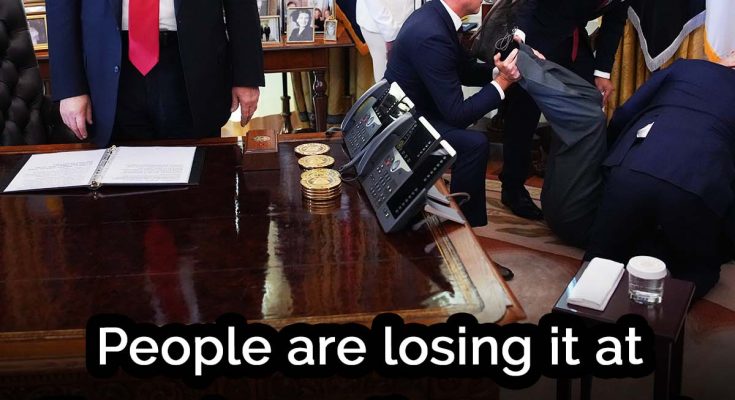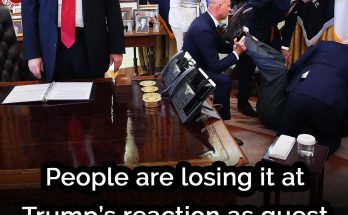Trump’s Reaction to Oval Office Medical Emergency Sparks Social Media Firestorm
A routine press conference in the Oval Office took a startling turn Thursday when a guest unexpectedly collapsed behind President Donald Trump, Dr. Mehmet Oz, and several attendees — an incident that quickly went viral and ignited a heated online debate over Trump’s reaction.
The event occurred as Dr. Oz, who currently serves as the administrator of the Centers for Medicare & Medicaid Services (CMS), was discussing the administration’s new initiative to lower the cost of popular weight-loss drugs such as Ozempic, Wegovy, and Rybelsus. Executives from pharmaceutical giants Novo Nordisk and Eli Lilly were in attendance, along with other key officials.
A Sudden Medical Emergency
As Dr. Oz delivered his remarks, the atmosphere in the Oval Office shifted abruptly. A guest standing behind the Resolute Desk suddenly collapsed, falling to the floor in full view of reporters and White House staff.
Members of the White House Press Corps were immediately ushered out of the room as security and medical personnel rushed to respond. Dr. Oz, a physician by training, quickly bent down to assist the fallen individual while the White House Medical Unit hurried to provide aid.
The once-orderly press event was instantly transformed into a scene of urgency and concern.
Early reports mistakenly identified the person who fainted as Gordon Findlay, a Novo Nordisk executive, but it was later confirmed that the individual was actually a representative from Eli Lilly. The confusion only fueled speculation online as images and clips began circulating within minutes.
White House Press Secretary Karoline Leavitt later provided an update, assuring the public that the individual was “doing okay” thanks to the swift intervention of medical staff.
“The White House Medical Unit quickly jumped into action, and the gentleman is okay,” Leavitt stated.
David Ricks, Chairman and CEO of Eli Lilly, echoed that reassurance. “If you’ve ever been in the Oval Office, you stand for a long time, and it’s warm,” he explained to ABC News. “I’m pleased to say that the White House medical staff did a great job, and he’s doing great — nothing to be concerned about.”
Trump’s Reaction Draws Scrutiny
As the incident unfolded, President Trump remained at his desk, observing the commotion but not appearing to intervene. His posture — calm, even nonchalant — quickly became a lightning rod for criticism once footage of the event surfaced online.
Images showing Trump standing still as others rushed to help the collapsed guest began circulating across social media, sparking accusations of detachment and insensitivity.
One viral Reddit comment summed up the frustration:
“Just replace the guy on the floor with America and we have the perfect painting for 2025.”
The remark was echoed by others who saw the moment as emblematic of what they perceive as Trump’s lack of empathy. Another commenter wrote:
“This photo perfectly encapsulates the Trump administration — people showing concern while Trump stands by, vaguely irritated that it’s not about him.”
Critics argued that Trump seemed unprepared to handle the situation, describing him as “unscripted for dynamic events” and “visibly disconnected” from the unfolding emergency.
The Conference Resumes
After a brief delay, the press was allowed to return to the room. President Trump addressed the incident with characteristic brevity.
“You saw he went down, and he’s fine,” Trump said. “We just sent him out and he’s got doctor’s care, but he’s fine. So we had a little bit of an interruption.”
While his comments were meant to reassure, many found them dismissive, pointing to the lack of visible empathy in both tone and demeanor. Others, however, defended the president, noting that his role in such situations is limited.
“He’s the president, not a doctor,” one supporter wrote online. “He did the right thing by letting the professionals handle it.”
A Divided Public Response
Public reaction to the incident remains deeply split. Supporters praised Trump’s composure and willingness to let medical experts take charge, arguing that intervening personally could have caused confusion or chaos.
Critics, on the other hand, argued that leadership often requires a human touch — a visible show of concern that transcends policy or protocol. For them, Trump’s detachment during the emergency reflected a broader pattern of emotional distance and image-conscious behavior.
As images of the moment continue to spread across platforms, the debate underscores the deep divisions that still define public perception of the former president.
While the medical emergency ended without tragedy, the political fallout has once again placed Trump at the center of a national conversation — not about policy or governance, but about empathy, optics, and the expectations of presidential leadership.
Whether the controversy fades or lingers, the incident adds yet another chapter to the complex and often polarizing legacy of Donald Trump’s return to the Oval Office.


